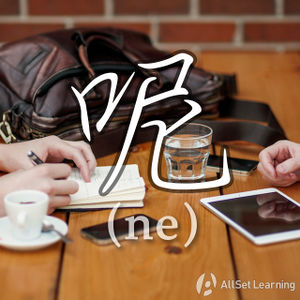Difference between revisions of "Questions with "ne""
| Line 6: | Line 6: | ||
<div class="jiegou"> | <div class="jiegou"> | ||
| − | Topic + 呢 | + | Topic + 呢 ? |
</div> | </div> | ||
| Line 26: | Line 26: | ||
* 我们 <em>呢</em>?<span class="trans">What about us?</span> | * 我们 <em>呢</em>?<span class="trans">What about us?</span> | ||
* 篮球 <em>呢</em>?<span class="trans">What about basketball?</span> | * 篮球 <em>呢</em>?<span class="trans">What about basketball?</span> | ||
| + | * 这里 很 多 人。那里 <em>呢</em>?<span class="trans">TRANSLATION</span> | ||
| + | * 北京 下 雨 了。上海 <em>呢</em>?<span class="trans">TRANSLATION</span> | ||
| + | * 这 个 用 中文 怎么 说?那 个<em>呢</em>?<span class="trans">TRANSLATION</span> | ||
| + | * 我 吃 饭 了。你<em>呢</em>?<span class="trans">TRANSLATION</span> | ||
| + | * 我 知道 你 会 说 中文。你 老公<em>呢</em>?<span class="trans">TRANSLATION</span> | ||
| + | * 这 个 周末 没 空?下 个 周末 <em>呢</em>?<span class="trans">TRANSLATION</span> | ||
| + | * 我 现在 要 出 去。你 <em>呢</em>?<span class="trans">TRANSLATION</span> | ||
</div> | </div> | ||
Revision as of 06:50, 5 September 2013
-
Level
-
Similar to
-
Used for
-
Keywords
The particle 呢(ne) can be used to ask reciprocal questions, also known as "bounce back" questions. 呢 can also be used to ask questions such as "what about" or "how about".
Structure
Topic + 呢 ?
And it's as simple as that. Say what you want to ask about, then stick 呢 on the end. A very common way to use this is to return a question after being asked it. The classic example is this exchange:
- A: 你 好 吗?
- B: 我 很 好。你呢?
- A: 我 也 很 好。
Examples
More 呢 examples (each of these can be translated as a "what about" question):
- 这个东西 呢?What about this thing?
- 你 妈妈 呢?What about your mom?
- 我们 呢?What about us?
- 篮球 呢?What about basketball?
- 这里 很 多 人。那里 呢?TRANSLATION
- 北京 下 雨 了。上海 呢?TRANSLATION
- 这 个 用 中文 怎么 说?那 个呢?TRANSLATION
- 我 吃 饭 了。你呢?TRANSLATION
- 我 知道 你 会 说 中文。你 老公呢?TRANSLATION
- 这 个 周末 没 空?下 个 周末 呢?TRANSLATION
- 我 现在 要 出 去。你 呢?TRANSLATION
See also
- Yes-no questions with "ma"
- Tag questions with "ma"
- Softening the tone of questions with "ne" (advanced article)
Sources and further reading
Books
- Chinese: An Essential Grammar, Second Edition (pp. 137) →buy
- Integrated Chinese: Level 1, Part 1 (3rd ed) (pp. 23-4) →buy
- Mandarin Chinese: A Functional Reference Grammar (pp. 300-7) →buy
- New Practical Chinese Reader 1 (新实用汉语课本1) (pp. 87-8) →buy
- New Practical Chinese Reader 1 (新实用汉语课本1)(2nd ed) (pp. 102-3, 251) →buy
- 40 Lessons for Basic Chinese Course (基础汉语40课上册) (p. 97)→buy
Websites
- East Asia Student: How to use 呢 (ne) in Mandarin



